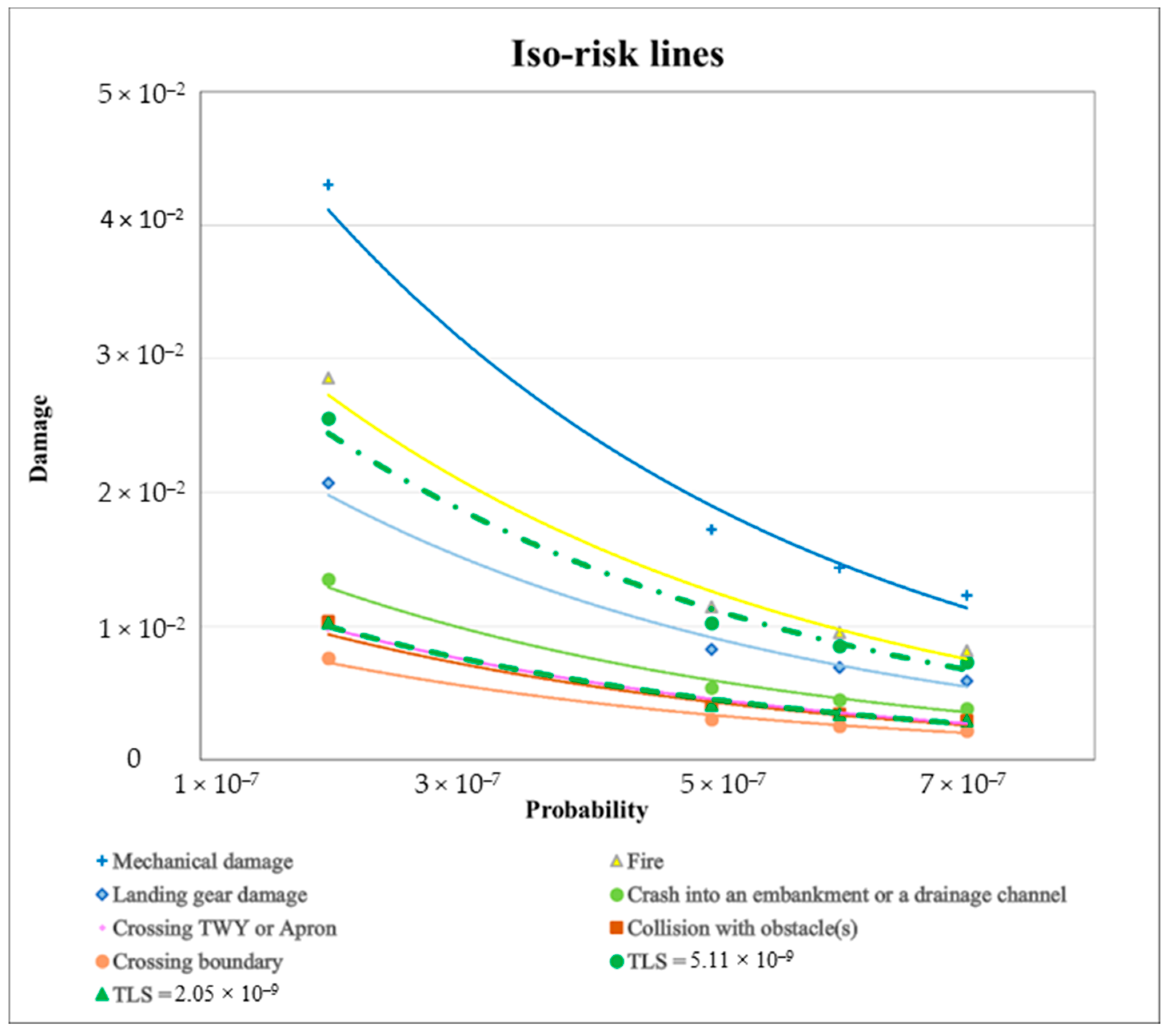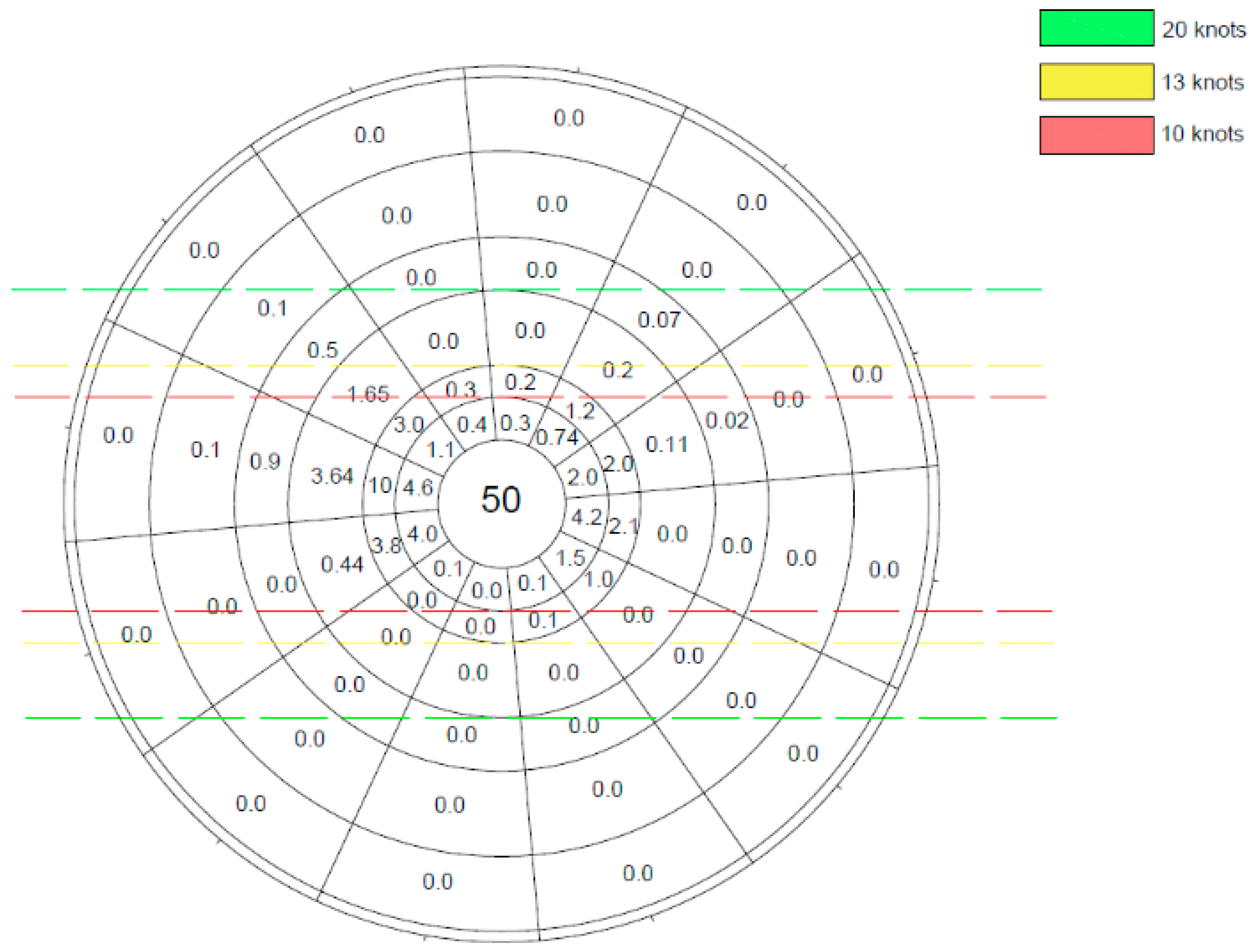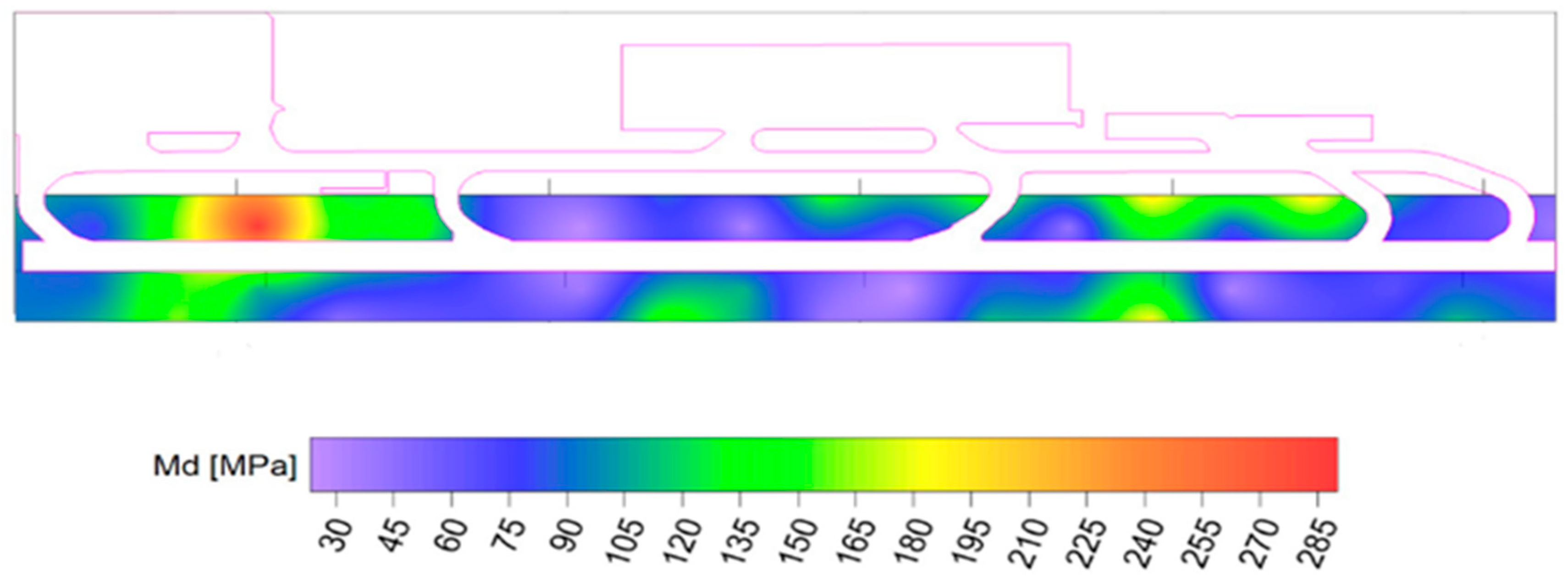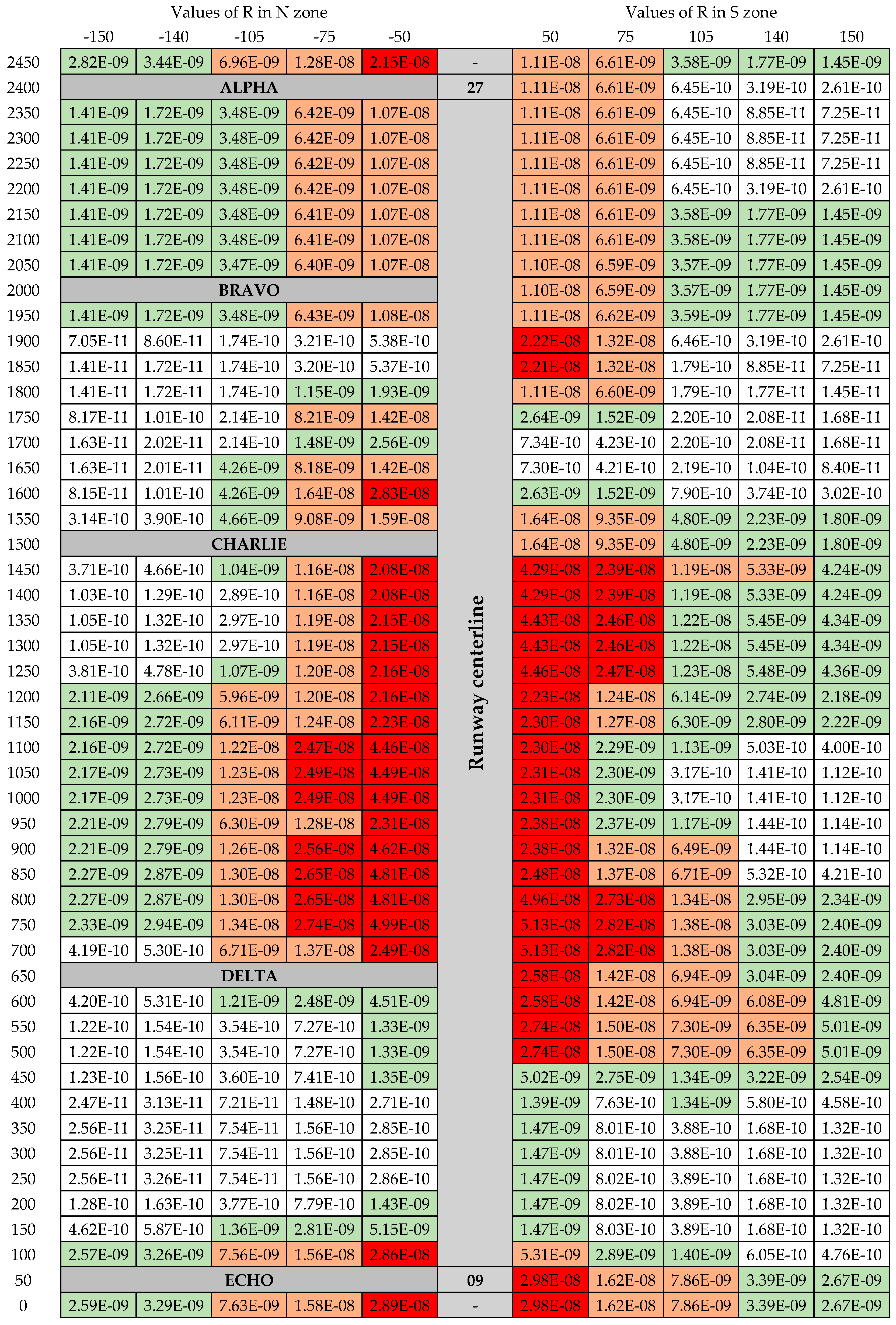1. Introduction
In the last decades, the issue of Runway Safety has been identified by the International Civil Aviation Organization (ICAO) as a priority for achieving global safety in the air transport system, as about half of accidents and serious incidents occurred nearby the runway [
1]. Such a high percentage of aviation occurrences has prompted ICAO to adopt a series of actions needed to improve runway safety. An example is represented by the Amendment Proposals of Annex 14 which refers to a new monitoring and evaluation system able to assess and report about runway surface conditions in order to reduce the risk of accidents related to runway contamination [
2].
When it comes to runway safety, Annex 14 describes a series of occurrence categories (e.g., undershoot/overshoot, loss of control on the ground, runway incursion). In particular, a category to be monitored is runway excursion, which nowadays represents the main risk for runway safety due to the high number of recorded events. De Couto [
3] explained that runway excursions continue to be an absolute priority because of their high frequency of occurrence. Indeed, they represent the most significant source of aviation accidents in the world, approximately 40–50% of accidents recorded by ICAO each year. Although in most cases, these events do not lead to fatal accidents, the risk of death for passengers and crew is still important [
4]. From the analysis of data collected in a database available to the authors containing aeronautical events that occurred around the world from 1996 to 2019, about 52% of accidents occurred near the runway, of which 41% of them belong to runway excursions, equally divided between veer-off and overrun, and most of them occurred during the landing phase (83%).
Studies in the literature shown that en-route flight involves only 12% of total accidents, even if it represents on average 57% of flight duration [
5]. In particular, the accidents are concentrated mainly in the initial and in the final phase of the flight. For this reason, it is extremely important to ensure large runway safety areas in each airport and to avoid the emergence of obstacles around the airport in order to reduce the number of air disasters and their consequences. The runway safety and operational protection areas constitute an effective mitigation element of the effects related to events classified as veer-off, overrun, and undershoot. In particular, the runway strip has the purpose of reducing the risk of damage to an aircraft diverting from the runway (veer-off accident) through specific requirements relating to the longitudinal and transversal slope of the Cleared and Graded Area (CGA) together with the strips and subgrade bearing capacity. The physical dimensions and all the characteristics of this surface are defined by [
6]. However, several airports have deviations related to the provision of a runway strip. The most common deviations concern the presence of non-frangible objects in the strips or a width not compliant with the values prescribed by ICAO. Additionally, regarding the Italian situation, almost all Italian airports were built during World War II as military airports. Therefore, the physical-territorial context and the anthropic development that has occurred over the years have influenced the airport/territory relationship and the potential expansion of infrastructures and/or adaptations of the runway safety areas.
These highlighted problems are common to most airports worldwide and have led international aviation authorities to consider the possibility of design solutions to manage non-conformities relating to airport infrastructures [
7]. ICAO standards substantially outline a prescriptive design approach, but [
6] allows the use of a more objective-based approach in some circumstances (e.g., aeronautical studies can support the aerodrome design process when there are deviations from Annex 14 prescriptions). Neither the nature of aeronautical studies nor any quantitative risk criteria are defined by [
6], even if it is specified that it has to include studies on quantitative risk analysis and the achievement of an appropriate target level of safety (TLS) [
8] to be compared to the real level of service (RLS). TLS is defined as a level of how far safety is to be pursued in a given context, assessed with the reference to an acceptable or tolerable risk [
9]; RLS is the maximum risk allowed for a veer-off accident. Having regard to the veer-off accident, in the literature, some research analyzes the associated variables and their categories of severity [
10], the probability [
11,
12] and the operational risk [
13]. Particularly, different approaches have been proposed to risk analysis in runway excursion (e.g., Bayesian-network based [
14], multiple Logistic regression method [
15], frequency model [
16,
17,
18]). This paper presents a quantitative risk assessment methodology from [
16,
17,
18] and the definition of the objective level of safety linked to the veer-off accident as well as its application to a case study; an international airport whose name will not be disclosed for privacy reasons. The study was carried out using the ICAO Safety Management Manual as a regulatory reference [
19] to assume the TLS. In the literature, there are lists of Target Level of Safety measures to be considered in civil aviation [
20], or under specified scenarios (e.g., collision between a landing plane and an aircraft located on a parallel taxiway or the wing collision between two taxiing aircraft on two parallel taxiways) [
21,
22]. TLS values defined by ICAO All-Weather Operational Panel (AWOP ICAO) and the Obstacle Clearance Panel (OCP ICAO) are related to:
Risk of hull loss during all phases from all causes: 1.00 × 10−7 per flight hour or 1.50 × 10−7 per mission (ICAO AWOP).
Risk of accident on approach and landing from all causes: 1.00 × 10−8 per mission (ICAO AWOP).
Risk of collision with obstacle due to aircraft being laterally off-path or beneath the approach path: 1.00 × 10−7 per approach (ICAO OCP).
The implementation of this technique permits to define objectively the level of risk associated to the considered accident; to establish if the infrastructural requirements can satisfy the required safety levels according to the specific data of a given airport; to adopt measures to mitigate the risk in order to bring the event back on acceptable levels of risk tolerance if necessary. Furthermore, the methodology herein presented to assess the level of risk in an airport allows airport operators to take objective decisions on infrastructural measures or operating procedures. Moreover, it significantly reduces the investments necessary to ensure an equivalent level of safety when a full compliance with the infrastructure requirements prescribed by Standards and Recommended Practices (SARPs) is not possible or feasible.
2. Analytical Methodology
The quantitative risk assessment of runway veer-off has been carried out with a methodology inspired by the one developed by the Italian Civil Aviation Authority (ENAC) with University of Rome La Sapienza, based on assessing the risk deriving from aeronautical activities in surrounding areas of airports [
23,
24,
25]. This methodology involves the creation of a structured set of methods and models to represent the risk through the product of the probability of occurrence with the damage severity.
The first model created is a veer-off accident frequency model to define the accident occurrence frequency, expressed through the ratio between the number of events recorded on total movements, which occurred in 20 years, between 1999 and 2018 [
5]. The value of 1.02 × 10
−7, approximately 1 event every 10 million movements, has been obtained considering among all the veer-off events occurred within Europe and North America to commercial aviation aircrafts with Maximum Take Off Weight (MTOW) over 60,000 pounds. Having regard to operations that took place in Asian countries, the frequency of occurrence of veer-off accidents would be higher, equal to 1.87 × 10
−7; it would grow even more, up to 3.2 × 10
−7, considering the accidents that have occurred all over the world. However, the Norwegian Civil Aviation Authority (NCAA) [
8] suggests considering only operations that took place within Europe and North America to define the accident occurrence frequency: this criterion considers a homogeneous sample for aircraft, airport standards and procedures. According to the value of 1.02 × 10
−7 and the database information about veer-off at landing and take-off or occurred veer-offs on instrumental or non-instrumental runways, it was possible to obtain the rates for flight phases and available instrumentation.
The second proposed model defines the geographic distribution of veer-off incidents in the runway strips. It permits to assess the probability that a veering aircraft exceeds a certain distance x measured across the runway axis. This model provides a subdivision into classes of the space inside the runway strip. According to the data collected from previous accidents about final positions of the aircraft wreckage diverting from the runway, the complementary cumulative probability of the continuous random variable has been calculated for each class, called Location. It expresses the distance measured transversely between runway centerline and the final position of the diverting aircraft. The analysis was conducted in a differentiated way for take-off and landing phases, and in both cases, the statistical regression model deduced was a negative exponential type. This approach complies with that proposed by [
26]:
where
a and
n are regression coefficient.
Frequency and location models allow estimating the probability for an aircraft to have a veer-off accident and to exceed a certain distance x during the veer-off. The probability that one of the two events occur is independent of the occurrence of the other, therefore, according to the Probability Multiplicative Theorem [
27], it is possible to combine the results obtained from the models described above and to obtain the probability that the aircraft is subjected to the veer-off incident and that it exceeds a certain distance x in diversion.
From the analysis of data collected in the database described in the Introduction, Equations (2)–(5) were derived to calculate the veer-off probability Equations (2)–(5) are valid for landings on instrument runways, for landings on non-instrument runways, for take-offs from instrument runways, and for take-offs from non-instrument runways, respectively:
where f is the frequency of an aircraft running beyond a certain distance, x, measured from the runway (RWY) centerline.
The examined airport has one instrument runway for air operations, so the adopted frequency curves are described in Equations (2) and (4).
Furthermore, the probability that an aircraft veers depends on the considered movement. Landing and take-off events are mutually exclusive (i.e., they cannot occur at the same time): according to the Additive Theorem of Probability [
27], the probability that an event will occur is given by Equation (6):
Lastly, a damage model of the veer-off accidents has been developed, which defines the average damage associated with the event. This model provides the Identification of the Hazards as a first step (i.e., the consequences associated with the veer-off) and, subsequently, the risk assessments associated with each hazard identified [
28]. Through the analysis of the investigation reports of aviation accidents collected in the database and published by National Investigative Agencies [
29,
30,
31,
32], it was possible to identify seven main events: crossing of the airfield perimeter fence; collision with obstacles; crossing of the taxiway, apron etc.; impact against a drainage channel, an embankment or other; damage to the landing gear; fire; mechanical damage to engines, propellers.
For each identified event, in accordance with the model proposed by Moretti et al. [
16,
17], Equation (7) permits to assess the severity of damage D in terms of the effects on the health of people (both passengers and crew members) on board the diverted aircraft:
where
Nfatalities is the number of deaths,
Ninjuries is the number of injured people,
Noccupants is the total number of people on board the diverted aircraft.
In the damage model, the frequency of occurrence and the severity of the associated damage are calculated for each event; the average damage associated with the veer-off accident is defined according to Equation (8):
The damage level D obtained is equal to 18%: despite having different databases, this value complies with [
17,
18].
The risk Rij associated with a hazard derives from Equation (9):
where:
where D
i severity of the i-th consequence associated to j-th hazard is considered.
According to Equation (9),
Table 1 lists the average level of risk obtained for each event.
Subsequently, the Risk Matrix has been defined, within which the risk is structured according to acceptability criteria. In the literature, there are different proposals for structuring risk and its acceptability. In this study, the authors considered the ICAO Safety Management Manual [
10] as a regulatory reference. The risk matrix in
Table 2 consists of five levels of risk probability and risk severity, while the identified acceptability criteria are three: the red characters refer to “intolerable” risks; the yellow ones to tolerable risks (i.e., acceptable based on risk mitigation); the green ones to “acceptable” risks (i.e., consequences are unlikely or not serious enough to worry).
Table 3 shows the safety risk tolerability matrix.
Given the results in
Table 1, frequency and damage scales are defined for the assessment of the risk tolerability. Secondly, every single hazard is assigned to a class according to previously calculated frequency and damage values. The selection of the frequency scale, as well as that of damage, is left to the safety analyst. He should attribute an alpha-numeric code to each hazard identified (
Table 4), place it on the risk matrix, and establish whether the risk is “acceptable”, “tolerable”, or “not tolerable”.
Furthermore, the risk matrix and the acceptability criteria are an analytical tool to define the Target Level of Safety (TLS), a measure of the level of safety that should be guaranteed in a given context. Therefore, in order to manage all “intolerable” risks of veer-offs, it is necessary to reduce the risk associated to aircraft fire and mechanical damage of engines, acting on both occurrence probability and damage severity. This implies that TLS is assumed equal to 5.11 × 10−9 and mitigation interventions need to achieve D equal to 5%: under such conditions, these risks are under a “tolerable” level (i.e., one veer-off incident for every 200 million movements).
On the other hand, to manage “tolerable” risks considered acceptable only based on risk mitigation, we should adopt more strict measures that allow us to achieve a TLS equal to 2.05 × 10−9, i.e., among the dangers identified, the overall risk result is “acceptable” if the accident can occur once every 500 million movements.
Based on the obtained results, the risk associated with the single identified consequences can be represented by iso-risk curves (
Figure 1), i.e., curves that connect all the points with the same risk value. In
Figure 1, the curve of TLS (i.e., 5.11 × 10
−9) represents the tolerability limit beyond which the risk appears “intolerable”; on the other hand, TLS equal to 2.05 × 10
−9 represents a tolerance limit below which risks are “acceptable”.
Once the TLS has been defined, it is possible to compare it with the overall current risk level deriving from the consequences model of the veer-off accident defined as Real Level of Safety (RLS) according to Equation (11):
RLS equal to 1.85 × 10−8 represents the maximum risk allowed for a veer-off accident: it is associated to D equal to 18% (i.e., damage severity classified as Major). Therefore, to reduce the risk and to reach a tolerable or acceptable level of safety, it is necessary to undertake a series of actions. Identified hazards should be managed to avoid conditions of catastrophic severity and to satisfy the proposed TLS.
The presented methods and models were adopted to assess the veer-off risk and compare it to RLS and TLS in order to identify the hazards connected to the event and use risk matrix and risk acceptability criteria introduced by ICAO Safety Management Manual [
19]. Given primary data provided by an airport operator, the methodology has been implemented in a case study to manage the damage risk.
Primary Data
Airport local conditions were considered to assess the risk of veer-off accident: primary data provided by the aerodrome operator refer to 2019 and concern the following aspects:
Wind: Hourly observations of wind direction and speed, for a total of 144,579 h, permit to calculate the usability factor of the aerodrome through the graphic method of the wind rose [
33] and to identify the prevailing direction of crosswind that is one of the main environmental factors that contribute to veer-off;
Traffic composition: This information includes the number of movements per ICAO category [
6] and MTOW of each aircraft;
Runway usage for take-off and landing operations: This information combined with traffic composition led to identify which points of the runway are most affected by aircraft movements and veer-off risk.
Presence of buildings inside the airport grounds: The equipment, the control tower, and the hangars can increase the risk of damage suffered by an aircraft diverted from the runway.
Geotechnical characteristics of the strip areas: These data contribute to calibrate the damage model and propose the damage matrix according to Moretti et al. [
18]. Therefore, human health, mechanical consequences for the aircraft, and subgrade bearing capacity were considered [
34].
Ultimately, wind conditions, traffic composition and runway use affect the probability of occurrence of the veer-off accident; while presence of buildings and subgrade bearing capacity affect the expected damage. The processing of all these data allows specializing the risk assessment of the veer-off accident defined in general terms in a risk assessment associated to the examined airport.














